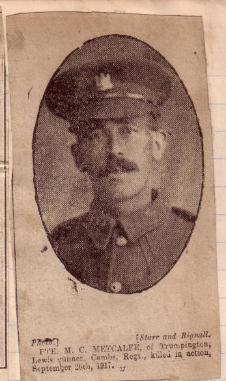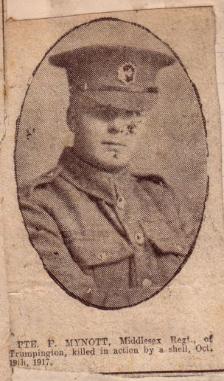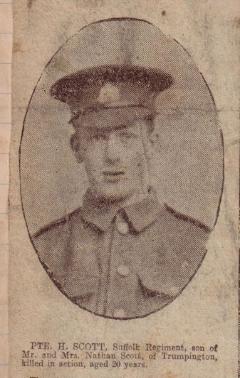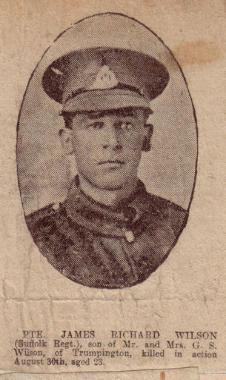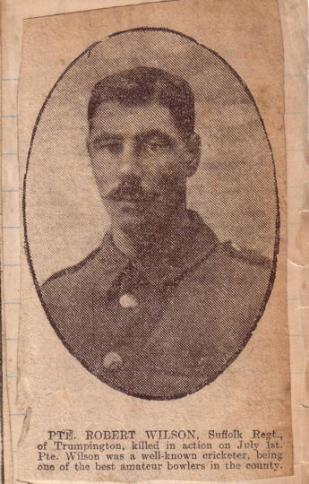This history of Trumpington War Memorial is based on talks given to the Group by Arthur Brookes on 26 November 2009 and 15 November 2018, together with additional information edited by Andrew and Wendy Roberts. It is one of a number of pages about the War Memorial.
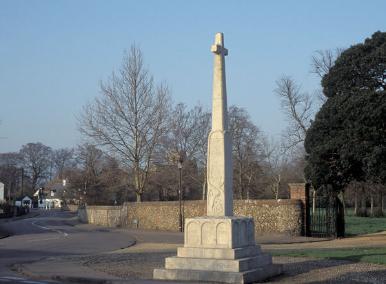
There has never been any national policy on the erection of war memorials, other than those laid down by planning authorities where the erection of a structure has necessitated compliance with certain regulations. Indeed for most of our history, war memorials were constructed to celebrate victories and remembering the dead was a secondary concern.
The Boer War was the first time that many memorials were erected, followed soon after by World War 1 which saw memorials constructed on a national and even global scale. A war memorial can take on many forms, from a monument, statue, plaque or more traditional symbol, such as the familiar structures we associate with many village war memorials. It could be argued that not all war memorials are classified as monuments, whereas many spectacular monuments are regarded as war memorials. The Menin Gate at Ypres, the American monument at Montfaucon (near Verdun) and the Canadian monument at Vimy Ridge are three such examples. Every year, the nation marks Remembrance Sunday with a ceremony at the Cenotaph in Whitehall. The Rev. H.V. Morton, writing in one of his many books, says a cenotaph is an empty tomb and the Collins English Dictionary goes further saying: “a tomb like monument, especially a war memorial to a person whose body is elsewhere”.
Many war memorials are in obscure, isolated and often forgotten locations. We are very fortunate that in Cambridge and here in Trumpington our war memorials are in very visible and prominent places where they can remind us daily of the true cost of the freedom we so often take for granted.
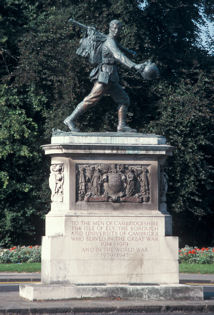
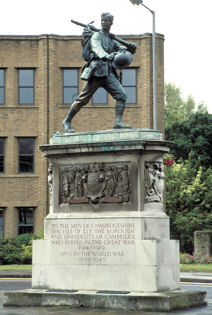
Deciding on a War Memorial for Trumpington
In Trumpington, there was much debate as to how the village would commemorate the fallen of World War 1. There is information about the process in Percy Robinson’s notes and the Parish Magazine.
Percy Robinson gives a brief background and a report on the first meeting to discuss the options, held on 8 May 1919. The Parish Magazine reported in its June 1919 issue:
“Memorial for the Fallen
A meeting arranged by a Committee of the Parish Council was held in the Village Hall on Thursday, 8th May at 7:30 pm, to consider what memorial should be made of the Trumpington men who had laid down their lives in the war.
Mr T.H.J. Porter took the Chair, and Mr P.R. Robinson was elected Secretary. The Chairman asked for suggestions as to the form which the proposed memorial should take. The proposals made were of three kinds: (1) a Tablet to be put up in the Parish Church, recording the names of the fallen; (2) a Cross or obelisk to be set up on Cross Hill; (3) the foundation of a Scholarship, or other educational help, to be of permanent benefit to natives of Trumpington, giving preference to descendants or relations of the fallen. The second of these suggestions seemed to find most general favour.
A Committee, consisting of Mr George Foster, Dr Guillemard and Mrs Wingate, with the Chairman and Secretary, was appointed to consider the various proposals, and to report to a future meeting of the parishioners. The meeting closed with a vote of thanks to the Chairman.
It is matter of great regret that there should have been so small and unrepresentative an attendance at a meeting to consider a matter which might have been expected to be of universal interest.”
It seems that the Committee found it difficult to come to a consensus. Percy Robinson adds that the next meeting was on 24 June 1920. The Parish Magazine reported on the meeting in its August 1920 issue:
“War Memorial. After about thirteen months of hard work the Committee summoned a Parish Meeting on 24th June. The Committee, it appeared, had failed to agree, and had no advice to give or proposal to make; but Mr Forbes, Dr Guillemard and Mrs Wingate were asked to explain individual suggestions of their own. After much desultory discussion the Meeting adopted Mrs Wingate’s scheme, subject to the required sum of money being raised. The same Committee was entrusted with the erection of the Memorial – a plain Cross designed by Mr Eric Gill – and it is to be hoped that no pains will be spared to improve the rough design submitted in the Meeting until it is as worthy as possible of its great purpose and of the perfect site which is provided by the open space on Cross Hill.”
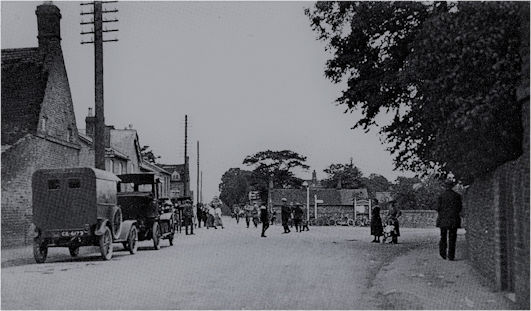
From Percy Robinson’s note and the Parish Magazine report, the driving force would seem to have been Dr and Mrs Wingate. Mrs Wingate was Viola Pemberton, the sister of Captain Francis Percy Campbell Pemberton, who had been killed in action on 19 October 1914. Eric Gill had been commissioned to create a memorial in the Parish Church to Captain Pemberton in 1915. Arthur Brookes notes that Dr Wingate met Eric Gill in Trumpington on 24 January 1920 to discuss the commission. Eric Gill sent a design for a carved cross shortly after, with his estimated cost of £400 to carry out all of the work, excluding carriage and installation, and agreed to make a model.
By September 1920, Arthur Brookes understands that the Committee had approved Gill’s design and were appealing for £400 from the public. Eric Gill wrote to Dr Wingate in October 1921 enclosing plans for the inscriptions and drawings of the four proposed carved panels.
In his note, Percy Robinson records that the next meeting of the Committee was on 15 November 1921, which was only a few weeks before the unveiling of the completed Cross in the open space at the junction of the High Street and Church Lane. By that point, the Cross itself had been sculpted and installed. There is a remarkable story about the discovery of the base of the old village cross when the foundations for the new memorial were being constructed on 17 August 1921. The base of the village cross was a large piece of Barnack stone, over two feet square at its base, the centre contained a socket, one foot square, with the remains of an original shaft. The location had continued to be known as ‘ Cross Hill ‘ even though the old village cross had disappeared at least 120 years beforehand. There was an additional significance in the location, at the entrance to Trumpington Hall, the Pemberton family home.
Old photographs show the road layout as it was before and after the memorial was erected, with a road on both sides of the memorial. The alignment of Church Lane was altered in 1937, removing the road between the memorial and the wall.
The cost of the memorial was £400 (approximately £17,000 in 2017 prices). In her talk on the Kindersley Workshop in November 2018, Lida Cardozo Kindersley explained that Eric Gill quoted £400 if he was to do the work himself. The amount was raised by public subscription, with the Pemberton family contributing £200.
Percy Robinson adds that the final meeting of the Committee was on 24 October 1923, when it was agreed that “the Trumpington Parish Council be asked to accept on behalf of the Parishioners the Trumpington War Memorial” on condition that no alterations were made to the Memorial without the consent of a parish meeting. No one then could have foreseen that there would be a second world war, by which time the village had been absorbed within Cambridge.
Unveiling and Dedication of the War Memorial
The unveiling and dedication of Trumpington War Memorial took place on Sunday 11 December 1921. Eight hundred copies of a commemorative booklet were produced for parishioners and other participants. This included a photograph and description of the new memorial and details of the service to be held in the Parish Church before the unveiling. The service commenced at 2:15 pm and was conducted by the Rev. A.C. Moule, the vicar of the parish, assisted by Rev. R.G. Bury, a former vicar, and Mr W. Campbell, the pastor of the Free Church. Before the start of the service, a muffled peal of bells was rung and the Cambridge Town Silver Band played sacred music in the churchyard.
After the service in the Church, there was a procession along Church Lane to the Memorial, “leaving the church in the following order:
The band playing a slow march.
The united choirs of the Church and Free Church.
The Ministers.
The Lord Lieutenant, invited guests, and War Memorial Committee.
The relatives of the fallen.
The ex-service men.
The members of the V.A.D. British Red Cross Society, W.A.A.C., W.R.N.S..
The school children.
The public.”
The booklet specifies that the band and choirs were to take up position on the east side of the Memorial, the relatives of the fallen on the south side on the Memorial, ex-service men and women on the London Road, and school children to the south west of the Memorial. The unveiling was carried out by the Lord Lieutenant of Cambridgeshire, C.R.W. Adeane, who gave an address. There was then a dedication by Rev. Moule and Mr Campbell, followed by the reading of the names of the fallen by Captain D.B. Ginn.
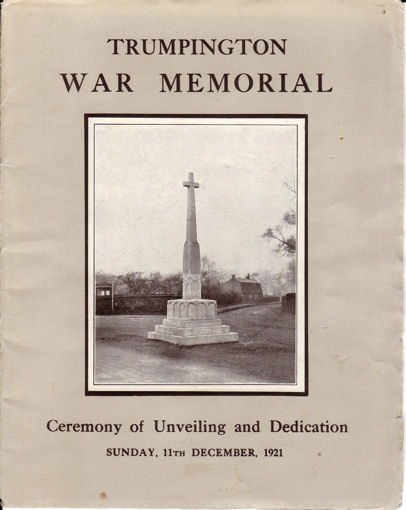

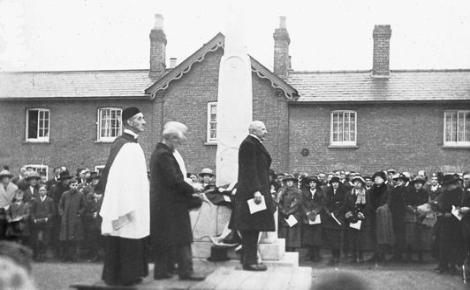
There was a detailed report on the ceremony in the Cambridge Chronicle , 14 December 1921, page 8, followed up by a page of photographs of the procession, the dedication and the memorial surrounded by wreaths, Cambridge Chronicle , 21 December 1921, page 9. The opening paragraph in the report on 14 December 1921 reads:
“There were three most touching scenes at the unveiling of the Trumpington War Memorial on Sunday. Probably the most poignant of all was the pathetic eight of those score or more children whom the war has made fatherless and who, with big staring eyes walked in the procession from the church to the memorial, thinking of Daddy who would never return; then there were the vacant pews in front of the ex-Service men, the meaning of which there could be no doubt; and, thirdly, there was the incident, expressive of the common sacrifice, the placing at the foot of the memorial of a large laurel wreath on behalf of the relatives of the Fallen, by the descendant of one of the oldest families in the country [Mrs Pemberton], who gave her only boy, assisted by a roadman [Mr Joseph Wilson], three of whose sons went to the Great War and bled and died for England.”
For this and other newspaper items, see Trumpington at War, 1914-18: as seen through Newspaper Reports.
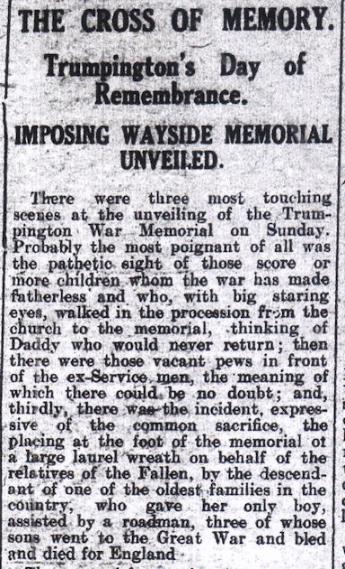
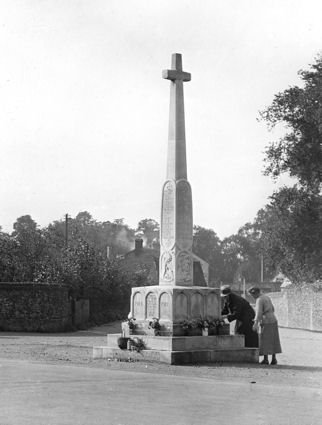
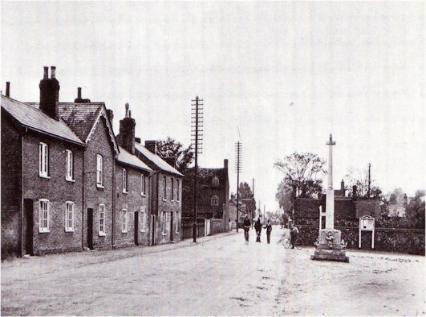
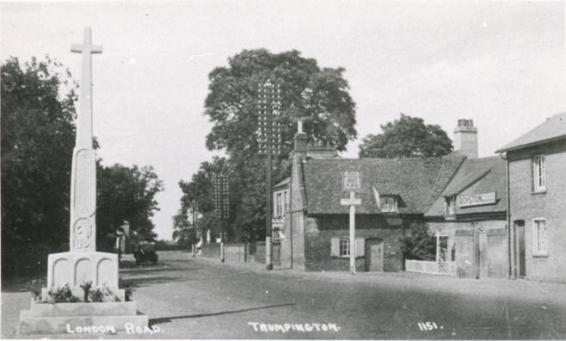
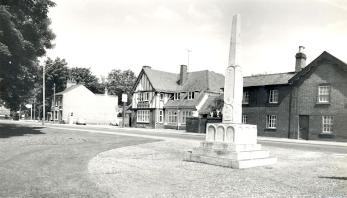
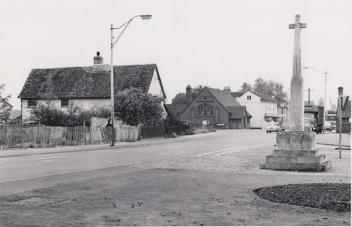
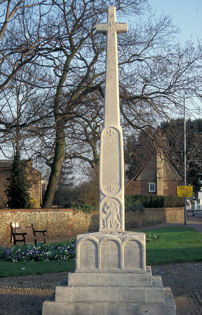
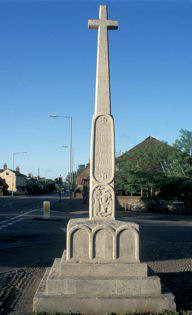
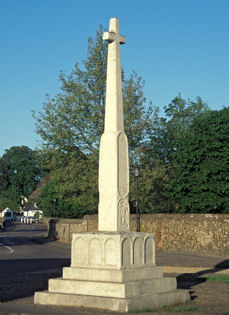
Design of Trumpington War Memorial
The War Memorial is one of the finest examples of the work of Eric Gill. Jeremy Pemberton had an uncle, Frank Rinder, the art correspondent of the Glasgow Herald . The two shared a mutual friendship with Edward Johnson, a calligraphic teacher at the Central School of Arts and Crafts. It was under his tutorage that Eric Gill had learned his craft. Trumpington Church already contained a memorial plaque to a member of the Pemberton family killed in action in 1914; the inscribing was the work of Eric Gill and it was largely through his connection with the family that he came to be associated with Trumpington war memorial.
Eric Gill came from a religious family; his parents were clergymen and missionaries. In the years between the wars, Eric Gill was known for both his sculpture and letter carving. Although sculpture had once been the main source of his public fame, this was to be overshadowed as more adventurous artists emerged. Eric Gill is still regarded as a master of letter carving. Trumpington war memorial is unique in that it combines both examples of his skills.
It was not unusual for artists to have little connection with work attributed to them, much of the work often being carried out by their pupils. Eric Gill was very much involved with Trumpington. In The Homecoming by K.S. Inglis (1992), David Kindersley and his apprentices refer to the whole work being designed and executed by Gill. He submitted designs to the memorial committee and in 1920 he was able to comment in a letter to a committee member that “with regard to the carving of the panels and the lettering, I will do these either myself or have them done by one of my pupils, which comes to the same thing”. (See footnote about David Jones and Eric Gill.)
There is further information about Eric Gill and the War Memorial in Lida Cardozo Kindersley’s talk about The Cardozo Kindersley Workshop and Trumpington and in Percy Robinson’s note.




The memorial contains four carved panels, above which the names of the dead are listed. The panels were carefully chosen to represent both St Mary and St Michael after whom the church is dedicated. St Mary is shown with the babe in a cradle whilst St Michael is slaying a dragon. The third panel is of St George slaying the dragon (St George being the patron saint of England) and the final panel depicts a weary soldier surrounded by shell bursts and broken tree stumps making his way home with his rifle slung over his shoulder.
Eric Gill based the soldier on a drawing of an infantryman by David Jones, who worked with Gill at Ditchling, Sussex. David Jones had served on the Western Front in the Royal Welch Fusiliers during World War I, experiences he used in his epic poem In Parenthesis.
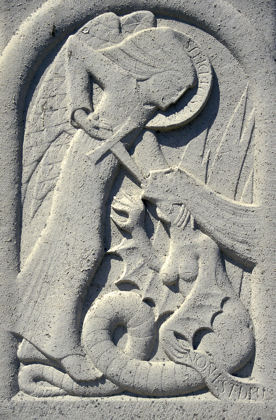
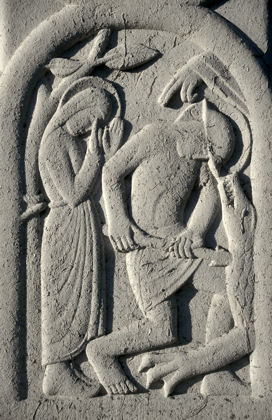
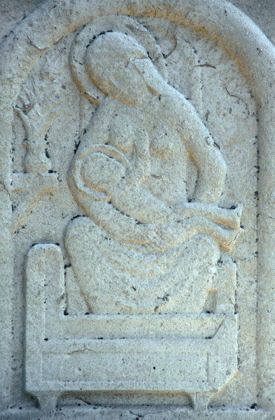
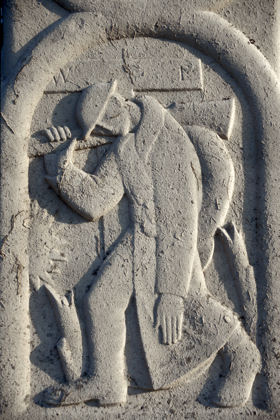
The names of the dead of World War 2 were added to the base of the Memorial in 1947. This was the work of David Kindersley, who had himself learned much from Gill’s skills and talents, having served his apprenticeship under the great man himself. There is more information about this in Lida Cardozo Kindersley’s talk.
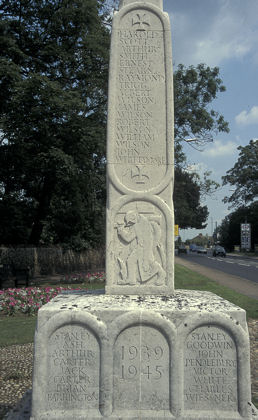
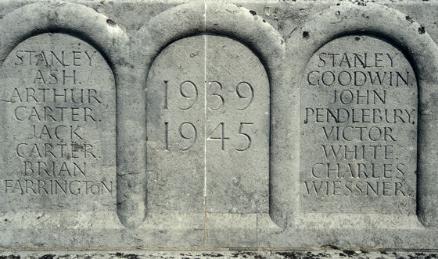
Constructed of Portland stone, the memorial has stood the test of time with the exception of the west panel, the stone of which seems to be slightly more porous than the rest. Being a sedimentary stone, the presence of fossils and soft indentations in Portland stone can lead to premature weathering and this seems to be the case. In 1969 the top of the cross was broken when someone attempted to climb it. The stone was re-fixed and the masons managed to clarify which way the cross faced from the blacksmith nearby.
Lida Cardozo Kindersley talked about the cleaning of the memorial. David Kindersley was consulted about this in 1950 and 1952 and advised that “only water and a washing up brush should be used”. Lida herself was consulted by the City Council in 2010, when a condition report was being prepared (Freeland Rees Roberts (2010). Trumpington War Memorial. Condition Survey, prepared for Cambridge City Council, February 2010.). Lida advised the Council to leave it alone, that the memorial was sound, had done its weathering and was in good condition.
The Local History Group was also consulted in 2010, when the main concern was the surroundings of the memorial, which was paved with cobbles which were very uneven and in poor condition. Following the condition report, the City Council’s South Area Committee (June 2014) recommended that the Council should approve a project to renovate the surroundings of the War Memorial. This work started in November 2014 and was completed in February 2015. As part of this project, an additional name was added to the World War 2 memorial, Lt. Jack Neville Creek, Argyll and Sutherland Highlanders. His family had pressed for some years that the omission of the name should be corrected. The name was unveiled at the service on Remembrance Sunday, 9 November 2014, 100 years after the start of World War 1.
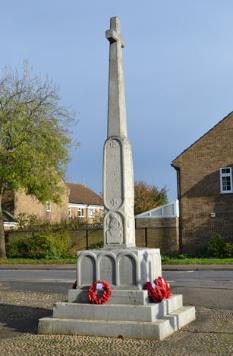
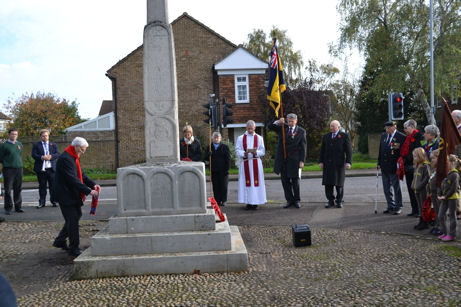
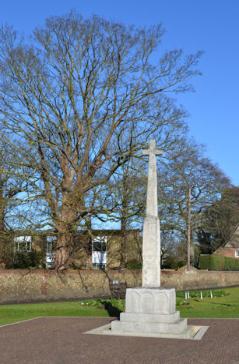
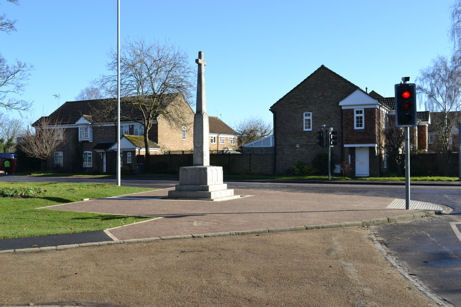
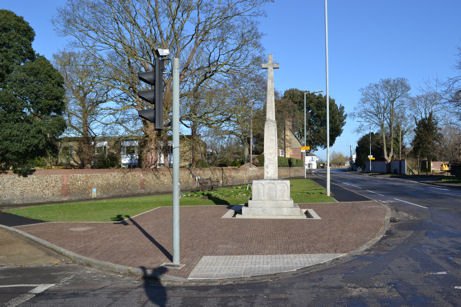

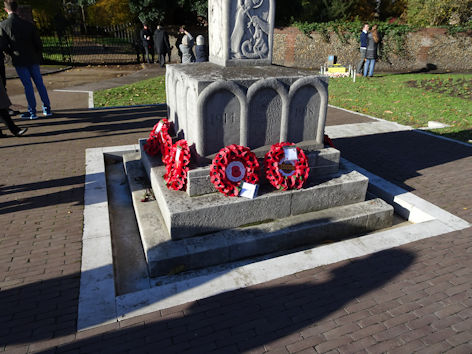
Individuals named on the War Memorial
Two of those listed on the memorial are buried in Shelford Road extension churchyard. One is commemorated with a Commonwealth War Graves Commission headstone: Albert Charles Wilson who died of injuries a week before the armistice was signed. The Wilson family suffered greatly as a result of the War. Mr Wilson senior worked as a shepherd and later as a roadman. The family lived in Workhouse Yard, more commonly known as Whitlocks Yard. They had four sons, three of whom were killed in the Great War, only the youngest son survived. The family also lost a son-in-law.
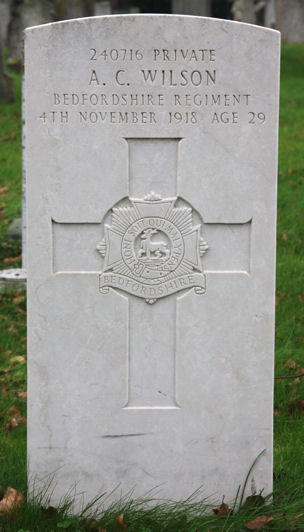
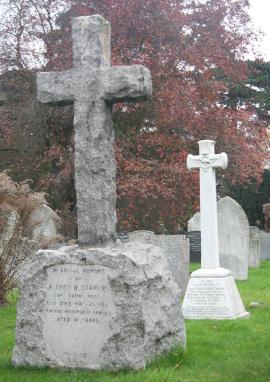
For information about these and other individuals, see the Trumpington community on the Imperial War Museum’s Lives of the First World War .
The name John Whittamore should have been engraved as Joseph Whittamore.
Newspaper commemorations of Trumpington soldiers
Many of the families who lost men during the war would place items in the local newspapers. A few examples are given below. See also the page about Trumpington at War, 1914-18: as seen through Newspaper Reports.
